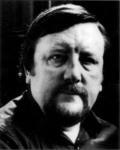|
|
||||||||||||||||||||||||
 |
Featured person
Recently added |
Nevill Johnson (1911 - 1999): |
||||||||||||||||||||||
Johnson was born in Buxton in the North of England in 1911 and attended Sedbergh School in Cumbria. Though he wanted to attend art school this was discouraged by his father. Largely self-taught, and working as a painter in his spare time, Johnson trained with John Luke when he first arrived in Northern Ireland in 1934 and forged friendships with a number of Belfast’s leading artistic figures, including John Hewitt and George MacCann. Johnson first exhibited a sculpture, Mother and Child, at the Ulster Academy of Arts in 1939 and in 1946 he showed paintings and sculptures alongside Max and Gladys Maccabe at the Magaffin Gallery in Belfast. Johnson executed a number of stone carvings and sculpture commissions during the 1940s however much of his early work has not survived or cannot be traced. Johnson’s paintings reveal influences of Surrealism and Cubism and his works during the 1940s regularly depict Northern Irish subjects including Kilkeel shipyard and Linenscape. Johnson joined a group of artists, including Luke and MacCann, who lived and worked in Co. Armagh during the Second World War. Johnson then moved to Dublin in 1947 and was one of a group of Northern Irish painters, such as Colin Middleton, to be represented by the art dealer Victor Waddington. The Waddington gallery in Dublin held an exhibition of his work in 1949. He wrote an autobiography entitled The Other Side of Six, published in 1983. Johnson returned to live in England in 1959 and he died in London in 1999. His paintings as in the collections of the Arts Council of Northern Ireland, The Hugh Lane Gallery, the Ulster Museum and the Bank of Ireland.
| Born: | 1911 |
| Died: | 1999 |
| Emma McVeigh |
| Bibliography: Hall, D and O’Brien, E: Nevill Johnson 1911-1999: paint the smell of grass, Bangor, 2008; Hall, D and O’Brien E: “Nevill Johnson’s Dublin” in Irish Arts Review, 19 (3), 2002, pp. 68-75. |


Home | Our Policies | Plaques | Browse | Search | Sponsors | Links | Help | Contact
Privacy & Disclaimer | Cookie Policy | Site Map | Website Design By K-Point
© 2024 Ulster History Circle









